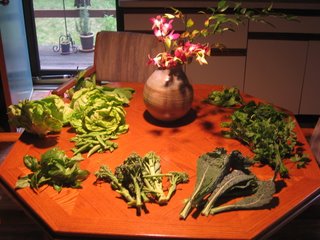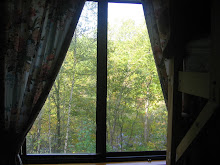The Illustrated Encyclopedia of Dog Breeds
This reference was put together by Joan Palmer. This is a great book if you don't really know much about dog breeds and want to get visually acquanited with some of the different breeds. There are about 200 different dogs here with a color photograph of almost each one. This book is no
AKC guide, but it is fun.
There is a short history of dogs in the front. There is also a section that describes the different dog features, jowls, nose, ears,
eyes...
Every time I look at this book I pick out a different couple of favorite dogs. The dogs I picked this time are the border terrier (
like Jack), and the
giant schnauzer.
Which ones would you pick?
How to Draw a Radish
I joined a
CSA and every week I get a bounty of great food. Here are my riches for this week.

Speaking of vegetables, this book, How to Draw a Radish and Other Fun Things to do at Work, by Joy Sikorski, is a fun little manual for wasting time. It does actually demonstrate radish drawing and other silly easy projects, like spider and cloud drawing, kite making, and telephone collage making. Hey all of you who work in offices: do people really have time to do stuff like this at work?
The Fourth Treasure
I have been having an extremely busy week (10 hours sleep since Sunday!), so I am behind on my reading. Here is a book from the vault.
This novel is by
Todd Shimoda with illustrations by his partner L.J.C. Shimoda. This book is a truly touching story of love and searching. It spans two generations and it tells the story of a love that spans Japan and USA, which involves the two who share(d) a love, their child, and others around them. The main characters are all creators - a
calligrapher, a scientific theorist, and one who makes art of life. Actually all three main characters make beauty of life. The connection that the characters share is their desire to make sense and art of their lives, in my opinion.
Wouldn't it be great if we all tried to make our own beauty from our lives?
After I read this book, I was so taken that I fervently wished I could go and live with the author and his wife so that I could experience their creativity first hand. Sadly this did not happen, but hey, Shimoda family, if you are reading this, I can still stay for a month or so...
Meetings with Remarkable Trees
This is a collection by Thomas Pakenham. This is what I think of as an adult picture book. It is filled with photographs of gigantic trees. "Remakable" translates to Pakenham as "big and old". There are tres in here that would take 12 people to wrap their arms around! There is on
old yew tree that has a large hollow space inside. In the early 19th century, the space was outfitted with a table and chairs and someone attached a door to the hole/entryway. The tree is gnarly and huge, and it is located in a graveyard.
This book is a feast for the eyes, especially
if you like trees. I give it a thumbs up.
Shake Them 'Simmons Down
This is a collection of essays by Janet Lembke. Lembke loves trees. So do I, so it was a good match here. The author lives in southeastern USA, and she writes about the trees that live near her, like the Catalpa, and persimmon (AKA 'simmon), and sassafras, and loblolly pine, and pawpaw. The
pawpaw. These trees are the very same never forgotten trees my friends and I called "poopy trees" for the fruit of these trees smell like, well...a baby's dirty diaper. We had only encountered them once on a summer trip we took, but their smell left a lasting impression on us. In this book, Lembke says that there was a
fancier's group for pawpaw trees and their smelly fruit! She said that people ate them! I called my mother to tell her about this and she told me that I too ate a relative of this fruit and loved it growing up.
This is a lovely book and the respect that the author feels for the trees around her shines through in her words.
Saving Fish From Drowning
This is a novel by Amy Tan. I like Amy Tan, I like her work a lot. That is why I was suprised that I felt so lukewarm about this, her latest effort. The book recounts the story of a group of US Americans who go on a tour to China and
Burma. Their guide, who is the narrator, dies right before the trip is to start, but the intrepid explorers forge on. Durijng their trip they are beset by challenges, and eventually end up being held captive by people who believe that they are doing no harm to the travelers and doing good for themselves. This period of captivity allows the travelers to look deeper into themselves and to get a small peek at the lives of their holders. They eventualy move from captivity, and their captors are the ones who don't survive (simply because they are who they are). I think this was an interesting book, but I felt that I only continued reading it to the end because I like the author.
Bombardier Beetles and Fever Trees
This book is subtitled A Close-Up Look at Chemical Warfare and Signals in Animals and Plants. Written by William Agosta. This is a fun book. It is really a language book - the chemical languange of living beings. Agosta examines the way plants and animals communicate through chemicals. He speaks of chemicals that living beings produce or sense to create effects such as a l
ightning bug's lightning, a tree's call to a complimentary fungus, and a Portugese Man-O-War's deadly toxins. This book is fun to read as well because it was written 10 years ago and we have perspective on some of the ideas and discoveries that were brand new at the time of writing. Agosta also speaks about a company researching
human chemical signals. A good book and a quick read.


